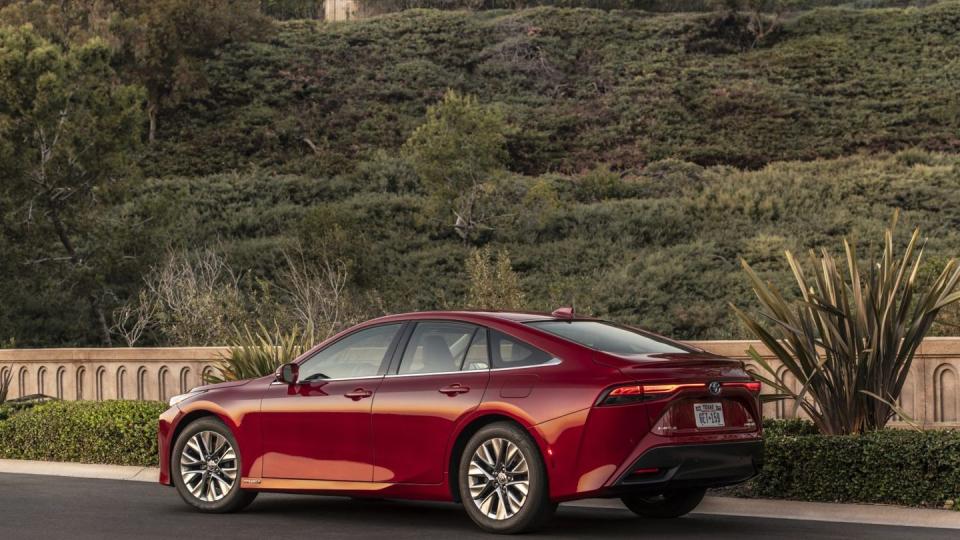Hybrid, EV, Plug-In-Hybrid, or Fuel-Cell Vehicle: How to Choose?

You may have encountered ads about "electrified" cars. Most people hear that name as synonymous with "electric" cars, but it's actually a broader category. An "electrified" vehicle is one that has an electric motor anywhere in the powertrain. Under that tent, you'll find hybrids, battery-electric vehicles, plug-in hybrids, and hydrogen fuel-cell vehicles.
Each of these has its pros and cons, and each may be a good (or bad) choice for a different set of buyers with different circumstances. So the question is, which will meet your needs the best? Here's our guide to help you sort it out.
Hybrids
On sale for more than 20 years now—the Toyota Prius is the best-known model—a hybrid-electric vehicle has one or two electric motors to supplement the output of its gasoline engine. On engine overrun or light braking, an electric motor turns into a generator to recharge the battery with energy that would otherwise be wasted. At low speeds or under light loads, hybrids can run on electricity alone for short periods.
There's a lot going on under the hood of a hybrid. That's due to control algorithms that modulate power delivery from the battery to the electric motors and demand power from a mixture of the motors and the engine. Today's hybrids are much quieter than those of previous eras, and owners may not know when their engine is switching on or off. As national emission standards tighten, hybrid models from most makers will increase—though you may not know they're hybrids except for a small badge.
Pro: Hybrids are the easiest type of electrified vehicle to use, because the driver doesn't have to change their behavior: They fuel it up just like any other gasoline car, except less often. (They also replace brake pads less often, since much of the braking is regenerative via the electric motor.) Hybrids are best for those who regularly cover long distances and unpredictable routes, for street parkers and apartment dwellers, and for people who simply don't want to learn about plugging in cars.
Con: Hybrids still cost more to buy than nonhybrids, though the difference is less than it used to be. It can be disconcerting for drivers to hear engine noise rising and falling without a commensurate change in road speed, though owners get used to it. Some people may view hybrids as nerdy or as a way to signal political beliefs. And, of course, you are still burning gasoline and spewing carbon dioxide (CO2) into our shared air.
Battery-Electric Vehicles
Conceptually, battery-electric vehicles are simple: They're powered by a battery under the floor, which has to be recharged. Ideally, that charging can take place at home and overnight, when electric rates may be cheapest. Roughly half the EVs in the U.S. today were sold by Tesla, which also built the ultra-reliable, seamless, and pervasive Supercharger fast-charging network. Because of that network, you can drive a Tesla just about anywhere in the lower 48 states.
Pretty much every other carmaker has launched or will soon unveil a variety of EV models, most of them the SUVs of various sizes and configurations that make up the heart of today's U.S. vehicle market.
Pro: EVs are smoother, calmer, and quieter to drive than vehicles with an internal-combustion engine (ICE). They have strong acceleration from a standstill, because electric motors develop maximum torque from zero rpm—and who doesn't like winning the occasional stoplight drag race? EVs have far fewer moving parts, so maintenance is largely a matter of replacing tires, wiper blades, and cabin air filters. And if you can charge them overnight at home, or at work during the day, they are much cheaper per mile than any gasoline car. Some EVs can export power through 120-volt electric sockets, to run a cooler or a stereo while parked. A few even serve as backup power for your house during blackouts, though there are several qualifications to that. And, remember, no tailpipe = no emissions.
Con: EVs are still pricier to buy than comparable ICE models, though that difference is narrowing and should vanish within a few years. If you can't charge where you live or work, public charging infrastructure can be unpredictable. Non-Tesla EVs rely on a variety of third-party charging networks, too many of which are not properly maintained or reliable. It shouldn't be that high a bar for EV charging to be at least as easy and pleasant as your local gas station, but that's still a work in progress. Not all EVs today have Tesla's seamless integration of navigation and charging, meaning owners have to do more planning for longer road trips. And EVs lose more range at high speeds or in very cold weather than gasoline vehicles do.

 Yahoo Autos
Yahoo Autos 